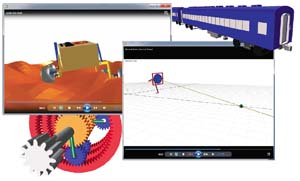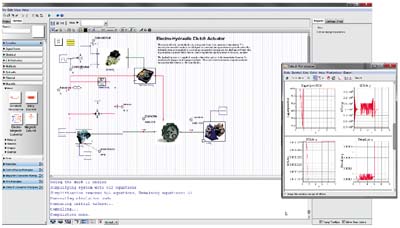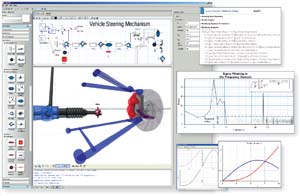Latest News
August 1, 2011
By Peter Varhol
In college, we learned engineering analytically, solving increasingly sophisticated structural, mechanical and electrical problems by formulating equations. Once in an engineering job, however experience starts to take over. In many cases, you do less analytical solutions and more real-world problem solving.
 MapleSim 5 includes improvements to the 3D modeling environment that make it even easier to construct and explore 3D models—including the ability to export 3D animation simulation results as movies. |
Maple and its simulation add-on, MapleSim, help bridge those two worlds, with the analytical tools to bring a level of precise computation to engineering problems—along with the flexibility to incorporate engineering experience into designs. Manufactured by Waterloo, Ontario-based MapleSoft, Maple is the analytical engine, a symbolic math machine that enables engineers to set up and solve problems as a series of equations. MapleSim can then take those solutions and execute them as parts of larger models that accurately execute those solutions over a range of parameters, providing a simulation as detailed as the equations themselves.
The result is a combination of mathematical tools for engineers, with the ability to build and execute models of complex real-world systems. While Maple is used for a lot of designs and simulations within the automotive industry, these tools can be applied to any engineering problem that requires sophisticated mathematics.
I used Maple 15, MapleSim 5 and the new MapleSim 3 on an HP engineering workstation, the Z600 model with dual 64-bit Intel Xeon processors, each with two cores, running at 2.8 GHz, with 12GB of memory. Installation of both products and license activation took only a few minutes, with no problems. This fast system ran Maple and MapleSim very well, with even the most complex calculations completed and displayed within a second or two. MapleSoft says that it has redesigned the math engine for many of the solvers, and claims the best performance of any similar solution. While I didn’t time the computations, execution of even relatively complex symbolic computations occurred within a second or two. On my mid-range engineering workstation, it’s certainly fast enough for just about any design.
One of the most important enhancements for Maple 15 is that it automatically utilizes all workstation processors and cores for computations that can take advantage of them. This requires some intelligence in both algorithms and implementation, but it means that parallelism is abstracted from the engineering effort of solving the problem. If it works as cleanly as advertised, it is a big win for complex computations. I tried to capture a sense of parallel execution with a series of parallelizable matrix operations while capturing Perfmon core utilization data, and saw multiple cores in use.
Further, Maple 15 allows you to launch multiple processes on all the cores of the desktop workstation, right from the user level without the need for any prior setup. The programming interface is the same as the one used for large-scale grid computing on a cluster or supercomputer, allowing engineers to easily prototype and test distributed code on the local workstation, then deploy the same code to a large grid or cloud.
Working with Maple
Maple lets engineers do a wide range of computations and analyses. You can do symbolic calculations—that is, calculations with variables rather than numeric values. But you can also create complex 2D and 3D graphs of those equations, modify the graphs by modifying the equations, and animating the equations. Further, you can create custom “fly-throughs” of these animations, giving you a continuous view as you traverse the graph from one end to the other.
 MapleSim’s multi-domain modeling environment lets you combine elements from different domains into a single model. This electro-hydraulic clutch actuator includes components from the new magnetics library in MapleSim 5, as well as electrical, mechanical and hydraulic components. |
All of these computations are performed in a Maple workbook, which is effectively a blank page upon which you type equations. You can simply solve those equations, symbolically or definitively if you insert actual values, or you can produce graphs of the resulting solutions. Standard equation components are available in libraries so that you can, to some extent, pick and choose the equations you need, which saves time and improves accuracy.
Maple provides the symbolic solutions to computational engineering problems. It enables engineers to build mathematical analyses to solidify design decisions, rather than make estimates that often result in over-engineering. MapleSim takes the results of those analyses and creates a functional and working model out of the equations. You can then go one step further and simulate the operation of these models, both examining the model visually and producing data that can be evaluated separately.
The improvements and changes in MapleSim 5 are significant. Open models lets you access model equations in full parametric form, and it automatically simplifies equations with no loss of fidelity. In other words, if a given simulation doesn’t include certain parameters, MapleSim has the ability to reduce the equations to exclude them, improving simulation performance.
MapleSim includes component libraries in areas such as magnetics, thermofluids, fluids, expanded electrical, and mechanical modeling. It enables 3D multi-body and 1D multi-domain in single environment, so that systems can be simulated more completely. Last, it generates code in C, MathWorks Simulink, National Instruments LabVIEW and dSPACE. Code produced by simulations can be used for hardware-in-the-loop operations, or even as embedded code in actual systems.
MapleSim Product Manager Derek Wright notes that individual engineers are being thrust into systems engineering roles beyond their specialties, as today’s complex systems combine mechanical, electrical and other components.
“Engineers need to be able to abstract away from the details somewhat to be able to integrate mechanical systems, electrical systems, computer software and other components into a completely engineered system,” he says.
Engineers can design according to their expertise, then integrate that design with pre-built components from the components library, or with components built by other engineering teams, to produce a full system. For example, an electrical engineer could design an electronic system for an aircraft fly-by-wire system, down to the circuit level. However, that engineer probably doesn’t have the skills to consider the aerodynamics of the aircraft using the system. These designs can be accomplished in Maple by a separate team, and incorporated as a black box component in the electronic feedback system by the electrical engineer.
Models for HIL Simulations
MapleSim adds an interface supporting dSPACE, a commonly used hardware-in-the-loop (HIL) development environment for embedded systems. This interface makes it possible to build out part of a hardware prototype, and insert MapleSim models to simulate the components under design—resulting in a system that is both real and modeled. The physical part of the system is often a harness or test bed that recreates known parts of the system, responding to or providing feedback to the running model to test its accuracy or other characteristics.
In support of HIL uses, MapleSim also generates code in several different programming languages. In addition to the ones noted above, the package can also produce traditional third-generation languages such as Java and C#, making it possible to run conventional code in embedded systems. It also includes an automotive driveline component library, which helps engineers design automotive products such as braking systems and drivetrains. These components enable engineers to work with standard models with known behaviors, which can easily be plugged into custom models to build and simulate more quickly.
 MapleSim is a physical modeling and simulation tool built on a foundation of symbolic computation technology. |
The result is that those who use mathematical models as part of HIL simulations can use MapleSim to build models that fit right into their simulation harness. It makes it possible to understand the parameters of the design early in the process, and test out alternative designs later on.
A Symbolic Math Foundation
Learning Maple and MapleSim isn’t difficult; most engineers familiar with the mathematics of their profession can be reasonably up to speed in a matter of days. Thanks to a broad array of examples, tutorials and courses, visual components, pre-defined equations, built-in libraries and other features, technical professionals can make use of it immediately, and enable their skills to grow with use. Help is also available through the Maple and MapleSim Application Center and MapleCloud; Wright told me that engineers have contributed a large number of applications and components for use by the community at large.
The primary advantage in using Maple and MapleSim is that it enables engineers to more quickly and precisely build and test models of complex designs. Doing the required math is so easy with these solutions that engineers can look at multiple design approaches and models, and still be assured that they aren’t over-engineering.
However, there are other advantages as well. The ability of engineers to integrate a comprehensive design across different engineering specialties is an important one, as is the ability to easily share designs, create powerful simulations, and use code embedded in electronic and electromechanical designs. Engineers seeking better designs through mathematical analysis and simulation can look to Maple and MapleSim as possible solutions.
Contributing Editor Peter Varhol covers the HPC and IT beat for DE. His expertise is software development, math systems, and systems management. You can reach him at [email protected].
For More Information:
Maplesoft
Subscribe to our FREE magazine, FREE email newsletters or both!
Latest News
About the Author
Peter VarholContributing Editor Peter Varhol covers the HPC and IT beat for Digital Engineering. His expertise is software development, math systems, and systems management. You can reach him at [email protected].
Follow DE





